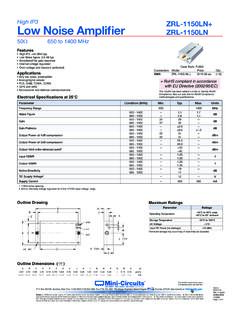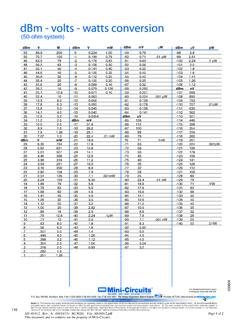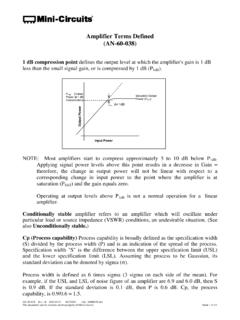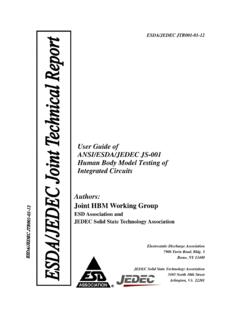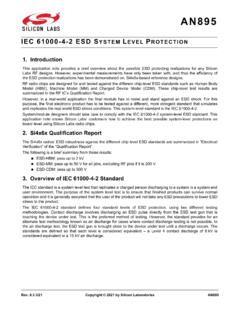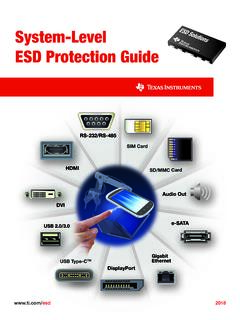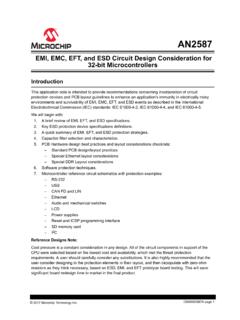Transcription of The Prevention and Control of Electrostatic Discharge (ESD ...
1 Page 1 Application NoteAN-40-005 Rev.: A M150261 (04/14/15) File: document and its contents are the property of Prevention and Control of Electrostatic Discharge (ESD)(AN-40-005)An Introduction to ESDWe experience occurrences of static electricity everyday. For example, walking along a carpeted floor in a heated room during winter generates sufficient static electricity to give us a rather shocking experience when we touch the door knob. While this sudden Discharge of static electricity does not result in any harm to the human body , it can be very damaging to electronic devices which are sensitive to Electrostatic Discharge (ESD).
2 It is possible for electronic devices to be damaged by ESD that is imperceptible to the human body . This document is intended to shed some light on the sources of ESD and provides guidelines on the Prevention and Control of or process Material or activity _Work surfaces Waxed, painted or plastic Waxed, common vinyl tiles, sealed concreteClothes Common smocks, non-conductive shoes, synthetic materials ( nylon)Chairs Vinyl, fiber-glass, finished woodPackaging Common plastic bags, foam, trays, tote boxesAssembly area Spray cleaners, heat guns, blowers, plastic tools ( solder suckers, brushes)
3 Cathode ray are the common sources of static electricity?The following table shows a sample list of sources of static are typical examples of static charge inducing situations? Does humidity have any effect on the induced static charge?The following table shows some typical situations. Please note that humidity has a significant effect on the induced charge. It is not recommended to have relative humidity (RH) that is too low, say, below 30%. ESD Control becomes especially challenging at low RH levels. A relative humidity between 40% to 60% is recommended for the typical assembly of static generation RH 10-20% RH 65-90%Walking across a carpet 35,000 V 1,500 VWalking on a vinyl tile floor 12,000 V 250 VVinyl envelopes for work instructions 7,000 V 600 VWorker at bench 6,000 V 100 VPage 2 Application NoteAN-40-005 Rev.
4 : A M150261 (04/14/15) File: document and its contents are the property of does damage from ESD happen?When a statically-charged person or object touches an Electrostatic Discharge sensitive (ESDS) device, there is a possibility that the Electrostatic charge could be drained through sensitive circuitry in the device. If the Electrostatic Discharge possesses sufficient energy, damage could occur in the device due to localized overheating. Generally, devices with finer geometries are more susceptible to damage from modes in which ESD damage occurs are:(a) Discharge to the device(b) Discharge from the device(c) Field-induced Prevention and Control of Electrostatic Discharge (ESD)What damage does ESD cause in an electronic device?
5 There are basically two categories of damage from ESD:(a) Catastrophic damage the electronic device is rendered inoperable immediately after the ESD event. A semiconductor junction or a connecting metallization could have been damaged by the Electrostatic Discharge .(b) Latent damage the electronic device appears to be working fine following the ESD event. However, the sensitive circuitry has been damaged and could fail to operate properly at some time in the are the classifications of ESD sensitivity? Electrostatic Discharge sensitive (ESDS) parts are commonly characterized to three defined models: human body Model (HBM) Machine Model (MM) Charged Device Model (CDM)Based on the models used, the ESDS parts can be classified in accordance with the following table (per MIL-STD-1686C, with HBM subgroups per ESD ).
6 It should be noted that the HBM, MM and CDM voltage levels do not correlate with each ModelESD ClassificationVoltage RangeHuman body Model (HBM)01A1B1C23A3B0V 249V250V 499V500V 1999V1000 1999V2000 3999V4000 7999V>= 8000 VMachine Model (MM)M1M2M3M4M50V 100V101V 200V201V 400V401V 800V>800 VCharged Device Model (CDM)C1C2C3C4C5C6C70V 124V125V 249V250V 499V500V 999V1,000V 1,499V1,500V 2,999V>= 3,000 VPage 3 Application NoteAN-40-005 Rev.: A M150261 (04/14/15) File: document and its contents are the property of of static charges in the work commonly used tool for the detection of static charges is the Electrostatic field meter.
7 This tool, when used in conjunction with regular audits on the production floor, is very effective in detecting the presence and magnitude of static charges. Care should be exercised to ensure adherence to the measurement distance as the meter is calibrated to specific distances from the measuring plane. Please consult the user s guide on the correct measuring distance for the specific Electrostatic field meter model that is being for Electrostatic Discharge Sensitive (ESDS) devices.(A) Work area:1. It is essential to handle ESDS devices at static-safe workstations.
8 This will prevent yield loss (through catastrophic damage) or, worse, potential reliability failures in the field (through latent damage). 2. Where it is impractical or impossible to use antistatic wrist-straps or remove items that are composed of insulative materials at a static-safe workstation, use an air ionizer designed to neutralize Electrostatic charges or apply topical antistats to Control generation and accumulation of static When an air ionizer is utilized, it is vital that maintenance procedures and schedules are adhered to in order to ensure that ions generated by the ionizer are sufficiently Avoid bringing sources of static electricity (as shown in page 1)
9 Within 1 meter of a static-safe work Where it is necessary to use air-guns, use special models that do not generate static charges in the air stream.(B) Personnel:1. Any accumulated charge on the body of the human operator should be discharged first before opening the protective container with ESDS devices inside. The Discharge can be accomplished by putting a hand on a grounded surface or, ideally, by wearing a grounded antistatic The use of an antistatic smock for each worker is highly Education and training on ESD preventive measures is A regular audit is also helpful in supporting an ESD program.
10 (C) Packaging and Transportation: ESDS devices should be contained in a static protective bag or container at all times during storage or Prevention and Control of Electrostatic Discharge (ESD)Page 4 Application NoteAN-40-005 Rev.: A M150261 (04/14/15) File: document and its contents are the property of materials are suitable for dissipating static electricity?It is recommended that static dissipative materials are used as the medium ( mats, containers) for discharging static charge to ground. These materials have the following properties:Surface resistivity: 1 x 105 to 1 x 1012 ohms/sqVolume resistivity: 1 x 104 to 1 x 1011 ohm-cmCautionary note: Materials which are conductive ( stainless steel surfaces) are not recommended for use as a static-safe work surface; the low electrical resistance could result in a transient-like (surge) Discharge of static electricity.



